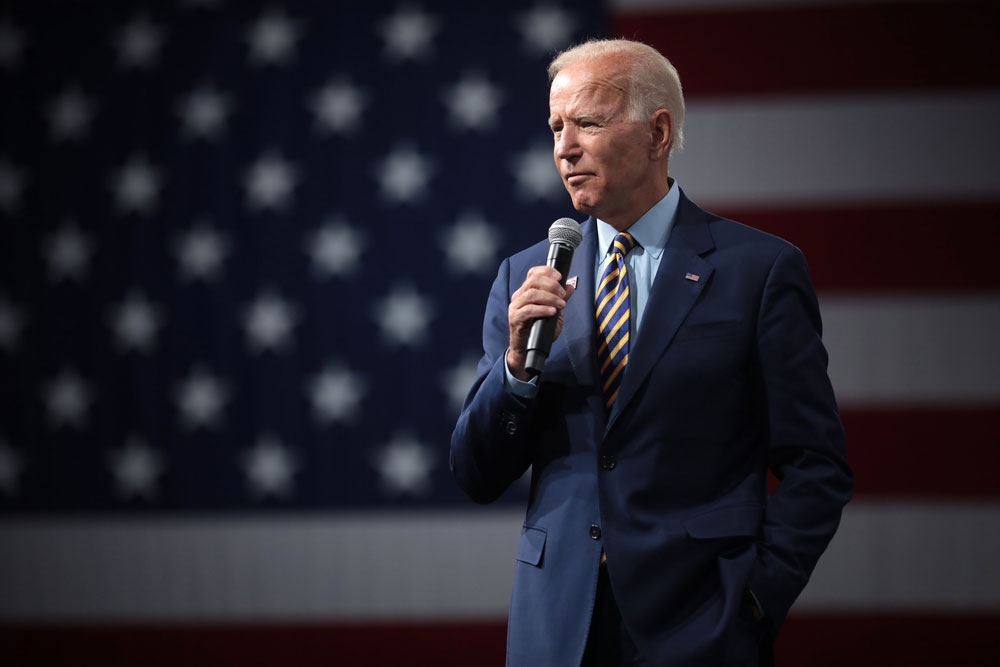

Last Thursday, President-Elect Joe Biden released a 19-page summary of his administration’s proposed $1.9 trillion coronavirus relief agenda, which his team has labeled the American Rescue Plan.
How much is $1.9 trillion? It works out to about $5,800 per person in the United States. Fortunately, as a recent paper by three prominent economists—former congressional budget office director Peter Orszag, former Treasury Secretary Robert Rubin, and Nobel laureate Joseph Stiglitz—documents, interest rates are at historic lows, making it considerably cheaper to borrow to meet the social needs exposed by the pandemic economy. While economic projections should never be taken for granted, current projections suggest continued “near-zero interest rates will last as far as the eye can see.”
An analysis by Moody’s chief economist Mark Zandi and his colleague Bernard Yaros explains why trillions of dollars in spending is needed. According to the two economists, Biden’s plan could reduce the length of the nation’s economic downturn by as a much as a full calendar year, meaning recovery could come in early 2022 rather than early 2023. Achieving this outcome, of course, would dramatically affect the well-being of many of the people that human services nonprofits aim to serve.
As Zandi and Yaros observe:
The pandemic…continues to ravage the finances of lower-income households and [people of color]. These groups were only beginning to recover from the financial crisis when the pandemic struck. Without substantial targeted government support like that proposed by Biden, their prospects are poor.
Indeed, as NPQ observed this past October, the COVID economic shutdown has—far more than any economic crisis before it—widened the gap between haves and have-nots, so much so that Americans in the top quartile had recovered to pre-pandemic employment levels by the end of September, even as Americans in the bottom quartile still were suffering Great Depression-levels of double-digit unemployment.
Just last week, Lael Brainard, a Governor of the Federal Reserve, reiterated this point, noting that “Federal Reserve staff analysis indicates that unemployment is likely above 20 percent for workers in the bottom wage quartile, while it has fallen below five percent for the top wage quartile.” Meanwhile, while vaccines offer hope, at present the pandemic itself continues to spread, with US fatalities now exceeding 400,000.
Breaking Down the Numbers
Providing legislation cost estimates is challenging. In some cases, there are precise numbers. But in programs with benefits (e.g., unemployment insurance), the actual cost depends on how many qualify for and claim the benefits offered. To develop the below chart, multiple sources are used, including the estimates by Zandi and Yaros, those of the Committee for a Responsible Budget, and the text of the Biden administration’s 19-page summary. Where there is a range in the estimates, that range is identified.
In broad terms, a little over half of the aid, or roughly $1 trillion, is in the form of support to individuals, whether this is in the form of direct checks, expanded unemployment insurance, rent and utility assistance, hunger alleviation, or childcare support. In addition, the bill would extend the eviction moratorium to September 30th.
Close to a quarter of the package, an estimated $415 billion, is tied directly or indirectly to addressing the pandemic. About $160 billion is tied to vaccination centers ($20 billion), expanded testing ($50 billion), vaccine manufacturing ($10 billion), emergency distribution support, like National Guard deployment ($30 billion), and international support ($11 billion). Other large items here are education funding ($170 billion), much of which ($130 billion) is geared toward improving ventilation in K-12 schools; paid sick leave; and subsidies to keep people from losing health insurance coverage.
The final quarter goes primarily to support state and local government, with modest added support for small business. The small business provisions include a $15 billion grant program to “hardest hit” businesses and $35 billion in loan financing. State and local governments—shut out in December’s bill—would get $350 billion and tribal governments (also shut out) would get $20 billion. Transit agencies, which got a modest $15 billion (far short of the need) in December, would get an additional $20 billion.
As NPQ has noted, federal transfers to state and local governments have been politically controversial. It’s hard to generate significant popular support to transfer money from one branch to another, even among nonprofits that earn an estimated $187 billion a year (four times as much as foundations provide) from state and local contracts.
Sign up for our free newsletters
Subscribe to NPQ's newsletters to have our top stories delivered directly to your inbox.
By signing up, you agree to our privacy policy and terms of use, and to receive messages from NPQ and our partners.
However, from an economic standpoint, the case for keeping state and local cuts from counteracting federal spending is clear. Think of the status quo as seeking to drive a car with one foot on the brake pedal. As Orszag, Rubin, and Stiglitz point out, “State and local spending, about one-third of all government spending, is largely constrained to satisfy balanced budget requirements, which are counter-productive in the midst of an economic downturn….In the Great Depression, the contractionary force was sufficiently strong to largely counteract the effect of the New Deal. It was also harmful during the 2008 global financial crisis.…The situation is the same with the COVID-19 crisis.” The Biden plan seeks to make avoiding state and local government cuts a priority.
More broadly, a summary of proposed allocations is outlined below:
Biden “American Rescue Plan”—Cost Estimates
| Item | Cost (billions) |
| Individual $1,400 checks (estimate) | 425-465 |
| $400 a week boost to unemployment (estimate) | 290-350 |
| Aid to state and local governments | 350 |
| Funding to K-12 schools and colleges | 170 |
| COVID-19 vaccine distribution, testing, contact tracing, etc. | 160 |
| Child tax credit expansion (estimate) | 120-149 |
| Paid sick leave (estimate) | 84 |
| Health Insurance subsidies (estimate) | 57 |
| Small business grant and loan programs | 50 |
| Support to childcare providers | 40 |
| Rent and utilities payment assistance | 30 |
| Transit | 20 |
| Tribal governments | 20 |
| Veterans’ health | 20 |
| Hunger alleviation (estimate) | 10-12 |
| Cybersecurity | 9 |
| Homelessness emergency aid | 5 |
| Mental health, domestic violence support grants | 5 |
To say the obvious, the proposal forwarded by Biden is certain to get amended in Congress. As is well known, the Democrats have a narrow 222–211 majority in the US House of Representatives and the US Senate is split 50-50, with Vice President Kamala Harris as the tiebreaker, giving the Democrats the narrowest possible of majorities. Under US Senate rules, budgetary items can be excluded from filibuster rules (which require 60 votes to overcome) through a process known as “reconciliation.” Even so, Biden’s proposal is sure to be amended in multiple ways before it becomes law.
There is a virtual cottage industry of pundits suggesting different political strategies. For example, David Dayen, writing in the American Prospect, advises the Biden administration to hold separate votes as a way to push through popular measures, such as the checks to families, more quickly.
There is also considerable debate about whether Biden, by proposing $1,400 checks on top of December’s $600 checks, is backtracking from his promise to advocate for $2,000 in support per person. Meanwhile, Biden’s bill also proposes $400 weekly federal supplemental payments for unemployment insurance through September 30th, compared to the $600 weekly payments of last spring—yet few seem to notice this change. Either measure—boosting checks from $1,400 to $2,000 or increasing weekly unemployment payments by an additional $200 a week—would cost $150-200 billion.
A Glimmer of a Vision?
Away from the noise, there are a few things worth pointing out in terms of what the bill (if passed) would do and won’t do. To be sure, this is an emergency relief bill—and that means that most proposals for structural changes are postponed for another day. We will have to wait until February to see a promised second bill that “will tackle the president-elect’s longer-term goals of creating jobs, reforming infrastructure, combating climate change, and advancing racial equity.” Also, notably missing from the relief plan is any measure whatsoever regarding student loan debt, although Biden has promised to extend loan payment forbearance by executive order.
In the spring, NPQ outlined some possible elements of what could be a new national direction. Most of the Biden relief package is far from transformative, but some elements hint at a possible broader social contract that might emerge.
- Universal Basic Income: The $1,400 per person payments in the legislation have proven to be widely popular. While these payments are not a “true” universal basic income, clearly today the idea of a base minimum income has gained countless adherents that it did not have a year ago. The Biden bill also extends support for unemployment insurance—not just the $400 weekly supplemental payments, important as those are, but the notion that gig workers and others who are outside the formal economy are still part of the unemployment system, something that was not the case until the CARES bill passed last March.
- Living wages: One key non-spending provision of the Biden relief bill is a proposal to raise the federal minimum wage from $7.25 an hour to $15 an hour. This provision would also get rid of current sub-minimum wages for tipped workers and disabled workers. Certainly, the increase in minimum wage will face opposition, but the fact that the measure made it into the relief plan does suggest that the discourse of “essential workers” may finally have a positive policy effect. Another boost to incomes comes by expanding child tax credits (from $2,000 to $3,000, with the credits made fully refundable—meaning a family receives the credit even if it doesn’t pay enough income tax to deduct the credit), which could reduce childhood poverty rates in the US by up to 40 percent—and, if enacted, have a good chance of being made permanent.
- Paid family leave: An estimated 179 countries offered paid leave for their workers before the pandemic; the United States did not. Biden’s relief proposal, if enacted, would change this, providing 14 weeks of paid sick leave through the end of September. As Claire Cane Miller explains in the New York Times, “If the Biden plan were to pass, it would replace workers’ wages up to $1,400 a week, or $280 a day. That means that people who earn up to $73,000 a year—three-quarters of American workers—would be reimbursed in full during their leaves.” Under the provisions of the legislation, the federal government will cover the cost for all employers with 500 employees or fewer, while larger employers would be expected to cover the cost.
Many hope that if the United States becomes the 180th country in the world to offer paid leave, it will continue to do so after the pandemic subsides. Among them is Senator Patty Murray (D-WA), who observes, “This policy is a big part of what workers need during these tough months, and it will serve as a strong foundation to finally establish permanent policies on paid sick days and paid family and medical leave.”
Conclusion
It is worth noting that the Biden relief plan remains a rough draft—there is not even legislative language drafted yet. Moreover, in the legislative process, many changes can be anticipated. It is also possible that Biden will decide to spin off distinct elements into separate bills, as some have advised.
The question of whether the US will adapt a new national direction remains a potent one, unanswerable until it is answered. Nine months ago, we noted in NPQ that, “We don’t know—yet—whether the shock of the pandemic, and the blatantly inadequate public and private sector responses to it, might open a window in our culture and allow meaningful policy change space to move in. But it is possible. We do know that what are sometimes known as ‘policy windows’ open and shut quickly.”
Nine months later, the question posed last May remains. As Crystal Hayling reminds us, the actions taken by Joe Biden and Kamala Harris will matter, but ultimately success will depend on the strength and power of social movement organizing. As Hayling puts it, “We are the only ones who can guarantee that our sense of power does not evaporate as the tough decisions begin.”













